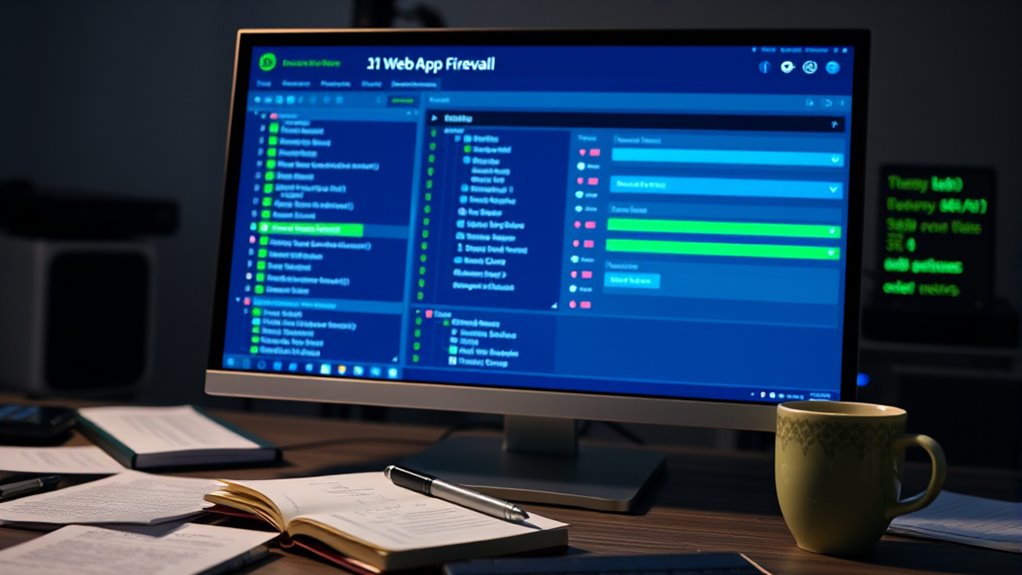Misconfiguring your WAF can create security gaps hackers exploit, especially if you rely on default settings or poorly crafted rules. Common mistakes include neglecting regular updates, using overly permissive rules, or failing to monitor logs effectively. These errors can lead to data breaches, downtime, and compliance issues. To avoid these pitfalls, it’s vital to optimize your WAF deployment continuously. Keep exploring to discover essential strategies that help safeguard your business.
Key Takeaways
- Default or poorly tailored WAF settings leave predictable gaps that hackers can exploit.
- Overreliance on generic rulesets can miss emerging or sophisticated attack techniques.
- Misconfigured input validation and request handling enable vulnerabilities like XSS, SSRF, and directory traversal.
- Failing to regularly update and patch WAFs exposes systems to known and zero-day threats.
- Inadequate monitoring and logging hinder early detection and response to malicious activities.
The Pitfalls of Default Settings in WAFs

Default settings in Web Application Firewalls (WAFs) may seem convenient, but relying on them can expose your web applications to significant risks. These settings are generic, designed for broad use, and often don’t fit your application’s specific needs. Cybercriminals know this and exploit predictable default configurations to bypass protection. Overdependence on defaults increases your attack surface and leaves gaps, especially if you don’t regularly update or tune rules. Default rulesets typically cover common threats but miss emerging or less common attacks, which sophisticated hackers can leverage. Without customization, your WAF might not address your unique business logic or traffic patterns, weakening your defenses. Recognizing the importance of security customization is vital to adapt your WAF to evolving threats and improve overall security. Ignoring these limitations makes it easier for attackers to find vulnerabilities and exploit them, risking data breaches and service disruptions. Regular review and customization are essential to adapt your WAF to evolving threats and improve overall security.
Crafting Effective Rules to Avoid False Positives and Negatives

Crafting effective WAF rules requires a strategic approach to balance security and usability. You should prioritize rules that cover broad traffic first, placing more specific or per-request rules later. Use terminating actions like *Allow* and *Block* carefully to prevent unintended gaps. Group rules into categories for easier management and avoid placing overly permissive rules at the top. Employ rate-based rules to mitigate floods and leverage managed rule groups for threats like IP reputation issues. Whitelisting offers high security but isn’t suitable for all, while blacklisting targets specific threats. Always test new rules in staging mode, preferably during low traffic periods, and monitor their impact continuously. Regularly update and tune rules to reduce False positives and negatives, ensuring your WAF remains effective and efficient. Regular review and understanding of Patchology.ORG resources can further enhance your security strategies.
The Importance of Regular Updates and Patch Management

Keeping your WAF and applications updated is critical for staying ahead of emerging threats. Timely security enhancements patch known vulnerabilities and help address zero-day attacks before they cause damage. Regular patch management guarantees your defenses remain effective and compliant with industry standards. Implementing virtual patching can provide an additional layer of protection during the window between vulnerability discovery and official vendor patches. Additionally, maintaining an up-to-date configuration ensures your security measures adapt to new attack techniques and evolving threat landscapes.
Timely Security Enhancements
Regular updates and patch management are essential for maintaining your web application firewall’s security posture. Performing regular patch audits helps you identify missed or failed updates, guaranteeing no vulnerabilities slip through. These audits verify that all systems and applications are current, reducing gaps that attackers could exploit. Automating patch deployment minimizes human error, speeds updates, and ensures consistency across complex environments. Scheduling patches during low-traffic windows and prioritizing critical vulnerabilities streamline your efforts, minimizing operational disruptions. Testing patches beforehand prevents outages caused by faulty updates and confirms compatibility. Maintaining an up-to-date asset inventory helps target unpatched systems and streamlines deployment. Continuous auditing, automation, and strategic planning keep your defenses robust, enabling proactive vulnerability management rather than reactive fixes. Regular patching is a fundamental component of a comprehensive security strategy.
Address Zero-Day Threats
Have you considered how zero-day threats can strike before developers even release a fix? These attacks exploit unknown vulnerabilities, leaving you vulnerable without an immediate patch. The cost of a breach in 2025 averaged over $5 million, with zero-day exploits markedly driving that expense. While WAFs use anomaly detection, virtual patching, and AI-powered analysis to block suspicious activity, staying ahead requires regular updates and threat intelligence. Prompt patching reduces known risks, but zero-day vulnerabilities demand continuous monitoring and quick response. Incorporating automated updates, threat intelligence feeds, and adaptive security rules helps your defenses evolve in real-time. Additionally, understanding the fundamentals of cybersecurity can help you better anticipate and mitigate emerging threats. Remember, the faster you update and patch, the less you allow attackers to exploit unseen vulnerabilities. Regular maintenance is your best defense against the unpredictable nature of zero-day threats.
Monitoring and Logging: Key to Detecting Security Incidents

Monitoring and logging are essential components of a Web Application Firewall (WAF) strategy, enabling you to detect security incidents early and respond swiftly. Integrating your WAF with a SIEM centralizes logs, providing thorough visibility and context for abnormal patterns or indicators of compromise. Real-time event correlation helps identify breaches sooner, while automated alerts on critical activities—like repeated login failures or SQL injection attempts—speed up responses. Starting in detection mode allows you to analyze traffic and fine-tune rules, reducing false positives before enforcing blocking. Rate-based rules and anomaly detection identify automated attacks, DDoS, and brute-force attempts. Regular log audits and automated alerts reveal misconfigurations and emerging threats, supporting continuous improvement. Incorporating threat intelligence and testing ensures your logs accurately reflect evolving attack techniques. Proper log management is vital for maintaining an effective WAF security posture, as it helps in identifying persistent threats and vulnerabilities over time. Additionally, attack patterns can be identified through comprehensive logs, enabling proactive defense measures.
Common Attack Vectors Exploiting Misconfigured WAFs

Misconfigured Web Application Firewalls (WAFs) can create significant security gaps that attackers exploit to bypass protections and launch attacks. For example, inadequate input validation allows SQL injection payloads to slip through, especially if rule sets are too permissive or outdated. Attackers can also bypass XSS defenses if WAFs don’t properly sanitize user inputs or lack contextual awareness, enabling malicious scripts to execute. Poorly enforced anti-CSRF tokens or missing request integrity checks open the door for CSRF attacks. Additionally, misconfigured WAFs might fail to detect HTTP request smuggling due to malformed headers or protocol ambiguities. To conclude, weak validation of server-side request URLs and file paths can facilitate SSRF and directory traversal attacks. These gaps allow attackers to exploit vulnerabilities that would otherwise be blocked by a properly configured WAF. Regular security audits are essential to identify and correct these configuration issues before they can be exploited. Proper WAF deployment strategies can significantly reduce the risk of such exploits by ensuring comprehensive coverage and up-to-date rule sets.
Business Risks and Compliance Implications of WAF Misconfigurations

When WAFs are improperly configured, businesses face significant risks that can threaten their financial stability, operational continuity, and legal compliance. Data breaches and system downtime caused by misconfigurations can lead to hefty financial losses. Attackers can exploit these gaps to compromise entire systems, resulting in extended outages and damage to your reputation. Non-compliance with data protection laws like GDPR or HIPAA can incur regulatory fines and penalties. Failing to meet security standards such as PCI-DSS or NIST increases audit failures and invites regulatory scrutiny, escalating costs and operational disruptions. Industry-wide, thousands of domains, including those of Fortune 1000 companies, are vulnerable. Over 140,000 domains linked to Fortune 1000 companies are affected by recent WAF vulnerabilities, misconfigurations not only expose sensitive data but also jeopardize your business’s legal standing and long-term viability. Proper WAF configuration and ongoing management are crucial to mitigate these risks effectively.
Practical Strategies for Secure and Optimized WAF Deployment

Deploying a WAF securely and effectively requires a strategic approach that balances protection with performance. First, start with a passive deployment to monitor and log traffic, ensuring you understand normal patterns before blocking. Then, consider these key steps:
- Conduct a proof of concept (PoC) to evaluate WAF effectiveness within your environment. This helps verify that the WAF rules will correctly identify threats without disrupting legitimate traffic.
- Choose between centralized or distributed deployment based on your infrastructure complexity.
- Identify critical applications and sensitive data requiring protection.
- Regularly tune and update rules to minimize false positives and address emerging threats.
Frequently Asked Questions
How Do I Identify if My WAF Is Misconfigured?
You can tell if your WAF is misconfigured by checking for signs like high false negatives, where malicious payloads go unblocked, or frequent legitimate user blocks. Look for outdated rules, lack of logging, or no alerts for known attack patterns. If you notice performance issues, persistent false positives, or no regular rule tuning, these are clues your WAF isn’t set up ideally, leaving your app exposed.
What Are the Signs of WAF Performance Degradation?
Think of your WAF like a guard dog losing its bark. Signs of performance degradation include increased latency, making your app feel sluggish, and bottlenecks that slow traffic flow. You might notice high resource usage or false alerts that disrupt user experience. If users complain about slow loading times or errors, it’s a red flag. Keep an eye on these signs to guarantee your WAF’s still sharp and effective.
How Often Should WAF Rule Sets Be Reviewed and Updated?
You should review and update your rule sets regularly, ideally at least monthly, to stay ahead of emerging threats. Keep an eye on vendor notifications and threat intelligence feeds to make certain you’re applying the latest rules. Conduct risk assessments periodically, and continuously test your WAF configurations. This proactive approach helps prevent vulnerabilities, reduces false positives, and maintains effective protection against evolving cyber threats.
Can a Misconfigured WAF Cause Legal Compliance Issues?
Think of a misconfigured WAF as a broken lock on your digital door—it invites trouble inside. If your firewall isn’t set up correctly, you risk failing compliance standards like GDPR or HIPAA, leading to legal penalties and fines. Regulators see these mistakes as negligence, and your organization could face lawsuits, investigations, or reputational damage. Properly configuring and auditing your WAF is essential to keep your legal and security risks at bay.
What Tools Assist in Testing WAF Security Effectiveness?
You can use various tools to test your WAF’s security effectiveness. Burp Suite and OWASP ZAP simulate attacks to identify vulnerabilities, while Nmap scans for open ports and exposed services. GoTestWAF generates detailed reports on potential bypasses, and Radware’s auto policy tools automatically create and adjust WAF rules based on testing results. These tools help you find gaps, strengthen defenses, and guarantee your WAF effectively blocks malicious threats.
Conclusion
To keep your web app safe, remember that a WAF is only as strong as its configuration. Don’t let mistakes be the cracks hackers slip through—think of your WAF as a garden that needs regular tending. Stay vigilant, update consistently, and fine-tune your rules. When properly maintained, your WAF becomes a sturdy shield, not just a barrier. Otherwise, it’s like building a fortress on shifting sands—fragile and easily breached.









